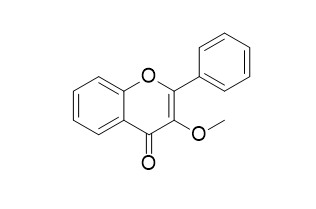3-Methoxyflavon
3-Methoxyflavone shows cytotoxic effects in human adenocarcinoma cell lines.
Inquire / Order:
manager@chemfaces.com
Technical Inquiries:
service@chemfaces.com
Tel:
+86-27-84237783
Fax:
+86-27-84254680
Address:
1 Building, No. 83, CheCheng Rd., Wuhan Economic and Technological Development Zone, Wuhan, Hubei 430056, PRC
Providing storage is as stated on the product vial and the vial is kept tightly sealed, the product can be stored for up to
24 months(2-8C).
Wherever possible, you should prepare and use solutions on the same day. However, if you need to make up stock solutions in advance, we recommend that you store the solution as aliquots in tightly sealed vials at -20C. Generally, these will be useable for up to two weeks. Before use, and prior to opening the vial we recommend that you allow your product to equilibrate to room temperature for at least 1 hour.
Need more advice on solubility, usage and handling? Please email to: service@chemfaces.com
The packaging of the product may have turned upside down during transportation, resulting in the natural compounds adhering to the neck or cap of the vial. take the vial out of its packaging and gently shake to let the compounds fall to the bottom of the vial. for liquid products, centrifuge at 200-500 RPM to gather the liquid at the bottom of the vial. try to avoid loss or contamination during handling.
Phytother Res.2015, 29(7):1088-96
Nat Commun.2023, 14(1):5075.
VNU Journal of Science: Med.& Pharm. Sci.2022, 38(2):2588-1132.
Bioorg Chem.2024, 145:107184.
Food and Fermentation Industries2019, 45(7):45-51
Phytomedicine.2018, 41:62-66
Int J Food Sci Nutr.2019, 70(7):825-833
J Biotechnol.2020, 318:10-19.
Plants2022, 11(3),294.
Cancer Lett. 2023, 18:216584.
Related and Featured Products
Molecules,2018 Sep 27;23(10):2477.
Glycosylation of 3-Hydroxyflavone, 3-Methoxyflavone, Quercetin and Baicalein in Fungal Cultures of the Genus Isaria.[Reference:
WebLink]
Flavonoids are plant secondary metabolites with a broad spectrum of biological activities. In nature, they occur mainly in the form of glycosides, but their extraction is often difficult and expensive, as is chemical synthesis. We have shown that biotransformations are an excellent method for obtaining flavonoid glycosides. We are the first team to describe the use of Isaria microorganisms in biotransformations of flavonoid compounds.
METHODS AND RESULTS:
In the present study as biocatalysts, we used one strain of Isaria fumosorosea KCH J2 isolated from a spider carcass in green areas of Wroclaw and two strains of I. farinosa (J1.4 and J1.6) isolated from insects found in already unused mines in Lower Silesia. The substrates were 3-hydroxyflavone, 3-Methoxyflavone, quercetin (3,3',4',5,7-pentahydroxyflavone), and baicalein (5,6,7-trihydroxyflavone). For all the substrates that were used in this study, we obtained 4-O-methylglucopyranosides. In the case of substrates with a hydroxyl group in the third position, O-β-d-glucopyranosides were also formed. Isoquercetin that was obtained by biotransformation was used as a substrate to check the kinetics of the formation of flavonoid 4-O-methylglucopyranosides in I. fumosorosea KCH J2 culture. We did not observe the attachment of the methyl group to glucose unit in isoquercetin.
CONCLUSIONS:
Our finding suggest that the attachment of 4-O-methylglucopyranose occurs in one step.



